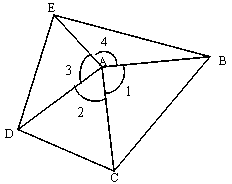Method for determining intermediate cutting intensity of natural secondary forest
A secondary and natural technology, applied in forestry, application, agriculture, etc., can solve the problem of lack of natural secondary forest density control technology, and achieve the effect of ensuring sustainable management effect, improving stand quality and simple method.
- Summary
- Abstract
- Description
- Claims
- Application Information
AI Technical Summary
Problems solved by technology
Method used
Image
Examples
Embodiment 1
[0029] A method for determining the intensity of tending thinning in natural secondary forests, comprising the following steps:
[0030] 1) Construct competitive structural units
[0031] The competitive structural unit is defined as the target tree as the center, and one tree closest to the target tree is selected in each of the four quadrants as the competitive tree, and the target tree and four competing trees form a structural unit. The area of the plane quadrilateral surrounded by the nearest four competing trees in the four quadrants of the object tree is called the area of the competition structure unit, such as figure 1 As shown, A is the target tree, B, C, D, E are the nearest competing trees in each quadrant of the target tree, ∠1, ∠2, ∠3, ∠4 represent ∠BAC, ∠CAD, ∠DAE, ∠EAB. AB, AC, AD, and AE are the horizontal distances between the object tree and four competing trees, respectively. Because the competition structure unit constitutes a plane quadrilateral, a...
Embodiment 2
[0052] Step 4) in the inventive method also can be in statistics natural secondary forest stand density N 现实 , after obtaining the average canopy radius of the natural secondary forest, use this radius as R to directly calculate the minimum reserved density N of the forest stand where the standard site is located through formula (1) 最少 , then compare N 最少 with N 现实 to determine whether to replant or thinn trees.
PUM
 Login to View More
Login to View More Abstract
Description
Claims
Application Information
 Login to View More
Login to View More - R&D
- Intellectual Property
- Life Sciences
- Materials
- Tech Scout
- Unparalleled Data Quality
- Higher Quality Content
- 60% Fewer Hallucinations
Browse by: Latest US Patents, China's latest patents, Technical Efficacy Thesaurus, Application Domain, Technology Topic, Popular Technical Reports.
© 2025 PatSnap. All rights reserved.Legal|Privacy policy|Modern Slavery Act Transparency Statement|Sitemap|About US| Contact US: help@patsnap.com



